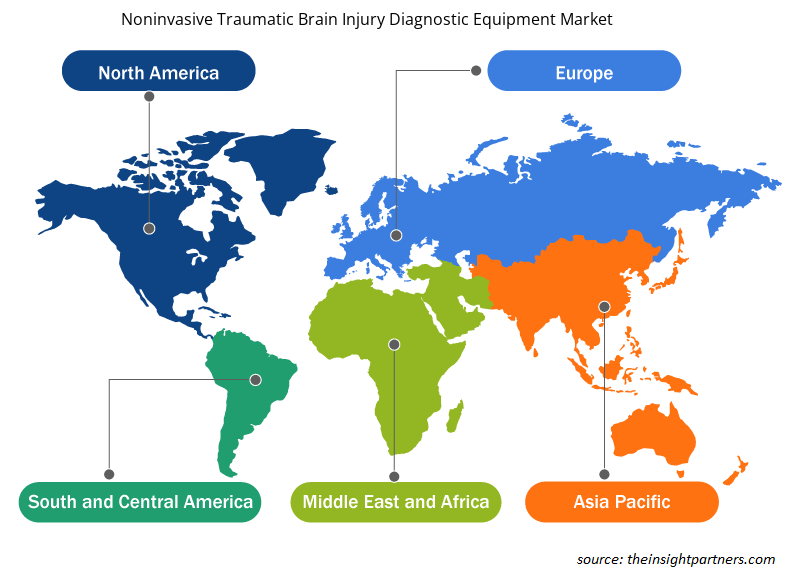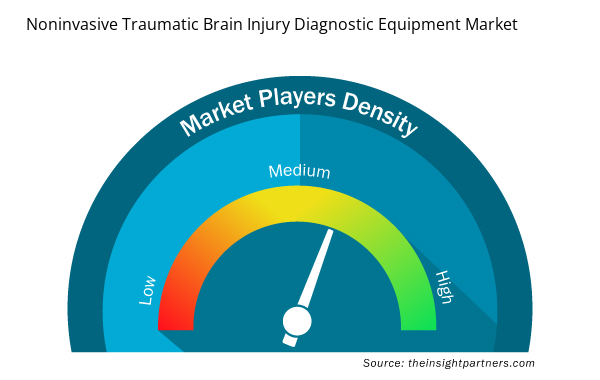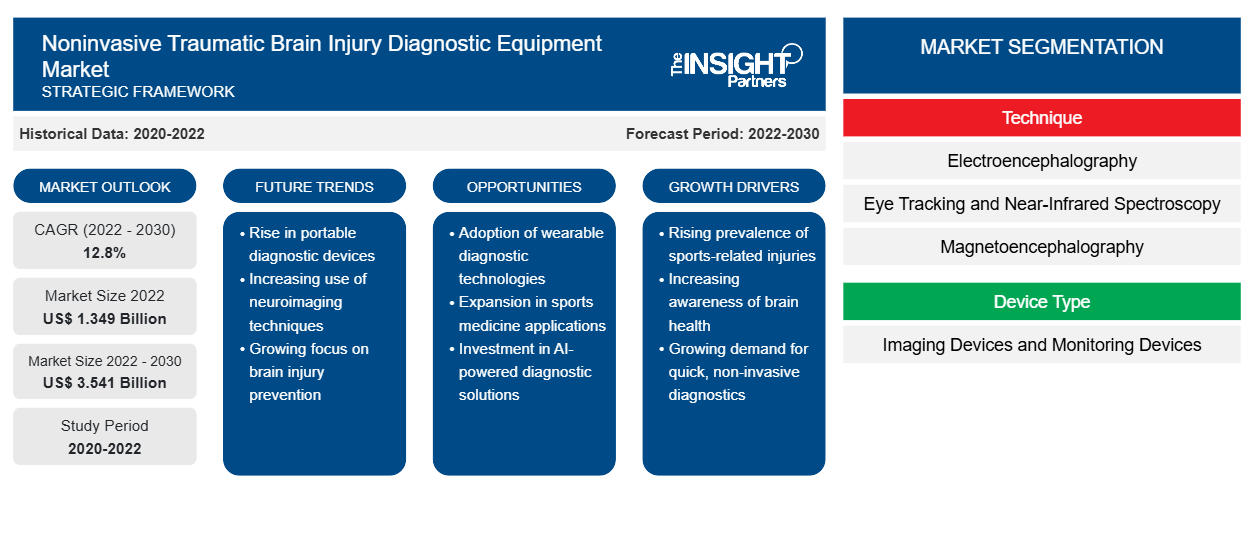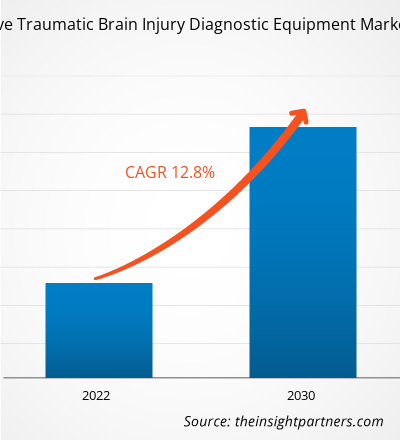[تقرير بحثي] من المتوقع أن ينمو سوق معدات تشخيص إصابات الدماغ الرضحية غير الجراحية من 1.349 مليار دولار أمريكي في عام 2022 إلى 3.541 مليار دولار أمريكي بحلول عام 2030؛ ومن المتوقع أن يسجل معدل نمو سنوي مركب بنسبة 12.8٪ خلال الفترة 2022-2030.
رؤى السوق ووجهة نظر المحلل:
إن عوامل مثل الطلب المتزايد على معدات التشخيص المتقدمة والتشخيص السريع والفعال لمرضى إصابات الدماغ الرضحية تعمل على دفع نمو سوق معدات تشخيص إصابات الدماغ الرضحية غير الجراحية . ومع ذلك، فإن التأثيرات السلبية لمادة/وسيلة التباين تعوق نمو السوق.
محركات النمو:
الطلب المتزايد على معدات التشخيص المتقدمة يدفع سوق معدات تشخيص إصابات الدماغ الرضحية غير الجراحية إلى النمو
وفقًا لتقرير مجلس البحوث الطبية لعام 2022، فإن 10 ملايين شخص في جميع أنحاء العالم يعانون من إصابات دماغية رضية ( TBI ) سنويًا. وبالمثل، كشف تقرير Headway 2024 أن إصابات الدماغ المكتسبة (ABI) آخذة في الارتفاع في المملكة المتحدة؛ حيث تم تسجيل ما مجموعه 356699 حالة دخول إلى المستشفى بسبب إصابات الدماغ الرضية في المملكة المتحدة من عام 2019 إلى عام 2020. ومن بين هؤلاء، كان عدد السكان الذكور أعلى بمقدار 1.5 مرة من الإناث اللائي دخلن المستشفيات بسبب إصابة في الرأس. ووفقًا لتقرير وحدة الاستخبارات الاقتصادية، فإن العبء الصحي العالمي لإصابات الدماغ الرضية يقدر بنحو 400 مليار دولار أمريكي سنويًا. الشكل الأكثر شيوعًا لإصابات الدماغ الرضية هو إصابات الدماغ الرضية بسبب حادث أو سكتة دماغية. كشف تقرير مراكز السيطرة على الأمراض والوقاية منها (CDC) أن ما يقدر بنحو 1.7 مليون زيارة لقسم الطوارئ ودخول المستشفى والوفيات المرتبطة بإصابات الدماغ الرضية تحدث سنويًا في الولايات المتحدة، وخاصة بين البالغين الذين تبلغ أعمارهم 75 عامًا أو أكثر لأنهم معرضون لخطر السقوط بسبب مشاكل في المشي والتوازن. كما أن حوادث الطرق هي السبب الرئيسي للوفيات المرتبطة بإصابات الدماغ الرضية في الولايات المتحدة وهي الأعلى بين البالغين الذين تتراوح أعمارهم بين 20 و24 عامًا. لذلك، يطور المصنعون منتجات مبتكرة لتشخيص إصابات الدماغ الرضية . في أكتوبر 2023، أعلنت شركة بيوميريوكس عن علامة Conformité Européenne (CE) لـ "VIDAS TBI (GFAP، UCH-L1)"، وهو اختبار يهدف إلى تحسين تقييم المرضى الذين يعانون من إصابات دماغية رضية خفيفة (mTBI). يقيس اختبار VIDAS TBI (GFAP، UCH-L1) تركيز البروتين الحمضي الليفي الدبقي (GFAP) وهيدروليز الطرف الطرفي C من اليوبيكويتين L1 (UCH-L1) - وهما العلامتان الحيويتان للدماغ اللتان يتم إطلاقهما في مجرى الدم بدءًا من الساعة الأولى بعد إصابة الدماغ. إنه اختبار سهل التفسير يوفر نافذة اختبار تصل إلى 12 ساعة بعد الإصابة، مما قد يساعد في تقصير إجمالي وقت الفحص في قسم الطوارئ. ومن المقرر إطلاق المنتج تجاريًا في عام 2023 في أسواق مختارة في أوروبا وشمال إفريقيا وأمريكا الجنوبية؛ ومن المقرر الإطلاق العالمي في عام 2024 أو 2025.
قم بتخصيص هذا التقرير ليناسب متطلباتك
ستحصل على تخصيص لأي تقرير - مجانًا - بما في ذلك أجزاء من هذا التقرير، أو تحليل على مستوى الدولة، وحزمة بيانات Excel، بالإضافة إلى الاستفادة من العروض والخصومات الرائعة للشركات الناشئة والجامعات
- احصل على أهم اتجاهات السوق الرئيسية لهذا التقرير.ستتضمن هذه العينة المجانية تحليلاً للبيانات، بدءًا من اتجاهات السوق وحتى التقديرات والتوقعات.
تقسيم التقرير ونطاقه:
تم إجراء "تحليل سوق معدات تشخيص إصابات الدماغ الرضحية غير الجراحية" من خلال النظر في القطاعات التالية: التقنية، ونوع الجهاز، والمستخدم النهائي.
التحليل القطاعي:
من حيث التقنية، يتم تقسيم سوق معدات تشخيص إصابات الدماغ الرضحية غير الجراحية إلى تخطيط كهربية الدماغ، وتتبع العين والتحليل الطيفي للأشعة تحت الحمراء القريبة، وتخطيط الدماغ المغناطيسي، والتحفيز المغناطيسي عبر الجمجمة، ومعدل التمثيل الغذائي للأكسجين في المخ، والتصوير بالرنين المغناطيسي، والضغط داخل الجمجمة، وواجهة الدماغ والحاسوب ، ومعدل التمثيل الغذائي للأكسجين في المخ، وغيرها. احتل قطاع التصوير بالرنين المغناطيسي أكبر حصة في السوق في عام 2022. ومن المتوقع أن يسجل قطاع تتبع العين والتحليل الطيفي للأشعة تحت الحمراء القريبة أعلى معدل نمو سنوي مركب بنسبة 14.3٪ خلال الفترة المتوقعة.
ينقسم سوق معدات تشخيص إصابات الدماغ الرضحية غير الجراحية، حسب نوع الجهاز، إلى أجهزة التصوير وأجهزة المراقبة. احتل قطاع أجهزة التصوير حصة سوقية أكبر في عام 2022 ومن المتوقع أن تسجل أجهزة المراقبة معدل نمو سنوي مركب أعلى بنسبة 14.5% خلال الفترة المتوقعة.
يتم تصنيف سوق معدات تشخيص إصابات الدماغ الرضحية غير الجراحية، حسب المستخدم النهائي، إلى المستشفيات والعيادات ومراكز التشخيص وغيرها. احتل قطاع المستشفيات والعيادات أكبر حصة في السوق في عام 2022 ومن المتوقع أن تسجل مراكز التشخيص أعلى معدل نمو سنوي مركب بنسبة 13.4٪ خلال الفترة المتوقعة.ظهور أجهزة مراقبة محمولة غير جراحية لتشخيص مرضى إصابات الدماغ الرضحية تعمل كأداة تشخيصية غير جراحية لإصابات الدماغ الرضحية الاتجاه المستقبلي
يمكن أن تساعد الطرق غير الجراحية الجديدة لمراقبة عملية التمثيل الغذائي للأنسجة في تحسين تشخيص ومراقبة حالات الدماغ مثل الارتجاج والسكتة الدماغية وإصابات الدماغ الرضحية، مما يسمح للمرضى بالتعافي بشكل أسرع. أدت عواقب إصابات الدماغ الرضحية إلى زيادة تكاليف الرعاية الصحية، والتي تمثل 76.5 مليار دولار أمريكي سنويًا، وفقًا للورقة البيضاء لشركة BrainScope. قد يؤدي تركيب "BrainScope One" في بيئات رعاية أقل تكلفة - مثل قسم الطوارئ والإعدادات المجتمعية (بما في ذلك مراكز الرعاية العاجلة) - إلى انخفاض كبير في تكاليف الرعاية الصحية بنسبة تصل إلى 32.2٪، وفقًا للنتائج التي تم الكشف عنها في الورقة البيضاء. يساعد BrainScope One في القضاء على عمليات التصوير المقطعي المحوسب غير الضرورية، وبالتالي تقليل تكاليف الرعاية الصحية لإصابات الدماغ الرضحية. وبالتالي، من المرجح أن يؤدي التقدم في تشخيص ومراقبة اكتشاف حالات الدماغ إلى فتح آفاق جديدة لاتجاهات سوق معدات تشخيص إصابات الدماغ الرضحية غير الجراحية في السنوات القادمة.
التحليل الإقليمي:
يغطي نطاق تقرير سوق معدات تشخيص إصابات الدماغ الرضحية غير الجراحية أمريكا الشمالية وأوروبا ومنطقة آسيا والمحيط الهادئ وأمريكا الجنوبية والوسطى والشرق الأوسط وأفريقيا. في عام 2022، احتلت أمريكا الشمالية أكبر حصة في سوق معدات تشخيص إصابات الدماغ الرضحية غير الجراحية.الولايات المتحدة هي أكبر مساهم في السوق في أمريكا الشمالية. كشف تقرير مراكز السيطرة على الأمراض والوقاية منها (CDC) أن ما يقدر بنحو 2.5 مليون شخص يعانون من إصابات الدماغ المؤلمة سنويًا في الولايات المتحدة. وفقًا لتقرير KNAPP & ROBERTS، يعيش 1 من كل 6 أمريكيين مع إعاقة مرتبطة بإصابات الدماغ المؤلمة في الولايات المتحدة وحدها، وهو ما يمثل حوالي 5.3 مليون. مع انتشار إصابات الدماغ المؤلمة المتزايد، تبلغ التكلفة الاقتصادية 76.5 مليار دولار أمريكي. من بين 76.5 مليار دولار أمريكي، يمثل 11.5 مليار دولار أمريكي التكاليف الطبية المباشرة ونحو 65 مليار دولار أمريكي للتكاليف غير المباشرة. تشمل الأسباب الرئيسية لإصابات الدماغ المؤلمة السقوط (45٪) وحوادث السيارات (14.3٪) والاعتداءات (10.7٪) والأسباب غير المعروفة (19.0٪).
بالإضافة إلى ذلك، أعلنت شركة Sense Neuro Diagnostics عن موافقتها على إجراء التجارب السريرية للكشف عن النزيف. بدأت التجربة الجديدة التي وافقت عليها إدارة الغذاء والدواء الأمريكية لأجهزة جراحة الأعصاب والتدخل العصبي والتشخيص العصبي في يونيو 2023، بما في ذلك ما يصل إلى 300 مريض في 30 موقعًا في الولايات المتحدة وكندا والهند. تتمتع هذه التقنية غير الجراحية بإمكانية جمع 360 نقطة بيانات في غضون 2.5 ثانية للكشف عن نزيف في المخ أو نوع السكتة الدماغية، وبالتالي المساعدة في الاستجابة السريعة من قبل الأطباء وموظفي قسم الطوارئ وفرق العناية المركزة العصبية والمستشفيات الميدانية العسكرية لتقييم ومراقبة إصابات الدماغ الرضحية. علاوة على ذلك، فإن إطلاق المنتجات المبتكرة من قبل الشركات التي تتخذ من الولايات المتحدة مقراً لها لتحسين نتائج تشخيص المرضى الذين يعانون من إصابات الدماغ الرضحية يحفز نمو سوق معدات تشخيص إصابات الدماغ الرضحية غير الجراحية.
تطورات الصناعة والفرص المستقبلية:
يمكن أن تساعد توقعات سوق معدات تشخيص إصابات الدماغ الرضحية غير الجراحية أصحاب المصلحة في هذا السوق في التخطيط لاستراتيجيات نموهم. فيما يلي قائمة ببعض التطورات الاستراتيجية التي قام بها اللاعبون الرائدون العاملون في سوق معدات تشخيص إصابات الدماغ الرضحية غير الجراحية:
- في أبريل 2022، أعلنت شركة Imeka عن تعاونها مع شركة GE Healthcare لتوسيع قدرات التصوير بالرنين المغناطيسي (MRI) وتطوير الطب الدقيق لصحة الدماغ. ستدمج شركة GE تقنية التصوير العصبي غير الجراحية من Imeka في معالجة الانتشار المتقدمة BrainWave، مما يسمح للباحثين والأطباء بتحليل الإصابات من خلال إشارات التصوير بالرنين المغناطيسي في الدماغ بتفاصيل كبيرة.
رؤى إقليمية حول سوق معدات تشخيص إصابات الدماغ الرضحية غير الجراحية
لقد قام المحللون في Insight Partners بشرح الاتجاهات والعوامل الإقليمية المؤثرة على سوق معدات تشخيص إصابات الدماغ الرضحية غير الجراحية طوال فترة التوقعات بشكل شامل. يناقش هذا القسم أيضًا قطاعات سوق معدات تشخيص إصابات الدماغ الرضحية غير الجراحية والجغرافيا في جميع أنحاء أمريكا الشمالية وأوروبا ومنطقة آسيا والمحيط الهادئ والشرق الأوسط وأفريقيا وأمريكا الجنوبية والوسطى.

- احصل على البيانات الإقليمية المحددة لسوق معدات تشخيص إصابات الدماغ الرضحية غير الجراحية
نطاق تقرير سوق معدات تشخيص إصابات الدماغ الرضحية غير الجراحية
| سمة التقرير | تفاصيل |
|---|---|
| حجم السوق في عام 2022 | 1.349 مليار دولار أمريكي |
| حجم السوق بحلول عام 2030 | 3.541 مليار دولار أمريكي |
| معدل النمو السنوي المركب العالمي (2022 - 2030) | 12.8% |
| البيانات التاريخية | 2020-2022 |
| فترة التنبؤ | 2022-2030 |
| القطاعات المغطاة | حسب التقنية
|
| المناطق والدول المغطاة | أمريكا الشمالية
|
| قادة السوق وملفات تعريف الشركات الرئيسية |
|
كثافة اللاعبين في سوق معدات تشخيص إصابات الدماغ الرضحية غير الجراحية: فهم تأثيرها على ديناميكيات الأعمال
يشهد سوق معدات تشخيص إصابات الدماغ الرضحية غير الجراحية نموًا سريعًا، مدفوعًا بالطلب المتزايد من المستخدم النهائي بسبب عوامل مثل تفضيلات المستهلكين المتطورة والتقدم التكنولوجي والوعي المتزايد بفوائد المنتج. ومع ارتفاع الطلب، تعمل الشركات على توسيع عروضها والابتكار لتلبية احتياجات المستهلكين والاستفادة من الاتجاهات الناشئة، مما يؤدي إلى زيادة نمو السوق.
تشير كثافة اللاعبين في السوق إلى توزيع الشركات أو المؤسسات العاملة في سوق أو صناعة معينة. وهي تشير إلى عدد المنافسين (اللاعبين في السوق) الموجودين في مساحة سوق معينة نسبة إلى حجمها أو قيمتها السوقية الإجمالية.
الشركات الرئيسية العاملة في سوق معدات تشخيص إصابات الدماغ الرضحية غير الجراحية هي:
- شركة جي إي لتقنيات الرعاية الصحية
- شركة اليكتا ايه بي
- شركة انتيغرا لايف ساينسز القابضة
- شركة ناتوس الطبية
- شركة راوميديك ايه جي
إخلاء المسؤولية : الشركات المذكورة أعلاه ليست مرتبة بأي ترتيب معين.

- احصل على نظرة عامة على أهم اللاعبين الرئيسيين في سوق معدات تشخيص إصابات الدماغ الرضحية غير الجراحية
المنافسة والشركات الرئيسية:
تعد GE HealthCare Technologies Inc وElekta AB وIntegra LifeSciences Holdings Corp وNatus Medical Inc وRaumedic AG وBrainScope Co Inc وLuciole Medical AG وSoterix Medical Inc وMedtronic Plc وVivonics Inc وNanoDx Inc وCompumedics Ltd وSense Diagnostics Inc وNeuraSignal Inc وNeurovigil Inc من بين الشركات البارزة التي تم عرضها في تقرير سوق معدات تشخيص إصابات الدماغ الرضحية غير الجراحية. تركز هذه الشركات على تطوير تقنيات جديدة وترقية المنتجات الحالية وتوسيع حضورها الجغرافي لتلبية الطلب المتزايد من المستهلكين في جميع أنحاء العالم.
- التحليل التاريخي (سنتان)، السنة الأساسية، التوقعات (7 سنوات) مع معدل النمو السنوي المركب
- تحليل PEST و SWOT
- حجم السوق والقيمة / الحجم - عالميًا وإقليميًا وقطريًا
- الصناعة والمنافسة
- مجموعة بيانات Excel



Report Coverage
Revenue forecast, Company Analysis, Industry landscape, Growth factors, and Trends

Segment Covered
This text is related
to segments covered.

Regional Scope
North America, Europe, Asia Pacific, Middle East & Africa, South & Central America

Country Scope
This text is related
to country scope.
الأسئلة الشائعة
TBI is a form of acquired brain injury and is categorized as mild, moderate, and severe. Therefore, diagnostics is utilized for effective diagnosis of TBI suffering patients. Computed Tomography (CT), Magnetic Resonance Imaging (MRI), and others are examples of noninvasive TBI diagnostics. Non-Invasive Methods for TBI Assessment mainly implies injuries to the neuronal network and recovery from it involves the forming of new circuits between surviving and damaged neurons, generating additional functional states and new gene expression profiles.
Key factors that are driving the growth of this market are accelerated demand for advanced diagnostic equipment and innovative product launches is expected to boost the market growth for the noninvasive traumatic brain injury diagnostic equipment over the years.
The CAGR of the noninvasive traumatic brain injury diagnostic equipment market during the forecast period of 2022-2030 is 12.8%.
The hospital & clinics segment held the largest share of the market in the global noninvasive traumatic brain injury diagnostic equipment market in 2022.
Global noninvasive traumatic brain injury diagnostic equipment market is segmented by region into North America, Europe, Asia Pacific, Middle East & Africa and South & Central America. North America held the largest market share of the noninvasive traumatic brain injury diagnostic equipment market in 2022.
The noninvasive traumatic brain injury diagnostic equipment market majorly consists of the players such GE HealthCare Technologies Inc, Elekta AB, Integra LifeSciences Holdings Corp, Natus Medical Inc, Raumedic AG, BrainScope Co Inc, Luciole Medical AG, Soterix Medical Inc, Medtronic Plc, Vivonics Inc, NanoDx Inc, Compumedics Ltd, Sense Diagnostics Inc, NeuraSignal Inc, and Neurovigil Inc, and amongst others.
The imaging segment dominated the global noninvasive traumatic brain injury diagnostic equipment market and held the largest market share in 2022.
Trends and growth analysis reports related to Life Sciences : READ MORE..
The List of Companies - Noninvasive Traumatic Brain Injury Diagnostic Equipment Market
- GE HealthCare Technologies Inc
- Elekta AB
- Integra LifeSciences Holdings Corp
- Natus Medical Inc
- Raumedic AG
- BrainScope Co Inc
- Luciole Medical AG
- Soterix Medical Inc
- Medtronic Plc
- Vivonics Inc
- NanoDx Inc
- Compumedics Ltd
- Sense Diagnostics Inc
- NeuraSignal Inc
- Neurovigil Inc
The Insight Partners performs research in 4 major stages: Data Collection & Secondary Research, Primary Research, Data Analysis and Data Triangulation & Final Review.
- Data Collection and Secondary Research:
As a market research and consulting firm operating from a decade, we have published and advised several client across the globe. First step for any study will start with an assessment of currently available data and insights from existing reports. Further, historical and current market information is collected from Investor Presentations, Annual Reports, SEC Filings, etc., and other information related to company’s performance and market positioning are gathered from Paid Databases (Factiva, Hoovers, and Reuters) and various other publications available in public domain.
Several associations trade associates, technical forums, institutes, societies and organization are accessed to gain technical as well as market related insights through their publications such as research papers, blogs and press releases related to the studies are referred to get cues about the market. Further, white papers, journals, magazines, and other news articles published in last 3 years are scrutinized and analyzed to understand the current market trends.
- Primary Research:
The primarily interview analysis comprise of data obtained from industry participants interview and answers to survey questions gathered by in-house primary team.
For primary research, interviews are conducted with industry experts/CEOs/Marketing Managers/VPs/Subject Matter Experts from both demand and supply side to get a 360-degree view of the market. The primary team conducts several interviews based on the complexity of the markets to understand the various market trends and dynamics which makes research more credible and precise.
A typical research interview fulfils the following functions:
- Provides first-hand information on the market size, market trends, growth trends, competitive landscape, and outlook
- Validates and strengthens in-house secondary research findings
- Develops the analysis team’s expertise and market understanding
Primary research involves email interactions and telephone interviews for each market, category, segment, and sub-segment across geographies. The participants who typically take part in such a process include, but are not limited to:
- Industry participants: VPs, business development managers, market intelligence managers and national sales managers
- Outside experts: Valuation experts, research analysts and key opinion leaders specializing in the electronics and semiconductor industry.
Below is the breakup of our primary respondents by company, designation, and region:

Once we receive the confirmation from primary research sources or primary respondents, we finalize the base year market estimation and forecast the data as per the macroeconomic and microeconomic factors assessed during data collection.
- Data Analysis:
Once data is validated through both secondary as well as primary respondents, we finalize the market estimations by hypothesis formulation and factor analysis at regional and country level.
- Macro-Economic Factor Analysis:
We analyse macroeconomic indicators such the gross domestic product (GDP), increase in the demand for goods and services across industries, technological advancement, regional economic growth, governmental policies, the influence of COVID-19, PEST analysis, and other aspects. This analysis aids in setting benchmarks for various nations/regions and approximating market splits. Additionally, the general trend of the aforementioned components aid in determining the market's development possibilities.
- Country Level Data:
Various factors that are especially aligned to the country are taken into account to determine the market size for a certain area and country, including the presence of vendors, such as headquarters and offices, the country's GDP, demand patterns, and industry growth. To comprehend the market dynamics for the nation, a number of growth variables, inhibitors, application areas, and current market trends are researched. The aforementioned elements aid in determining the country's overall market's growth potential.
- Company Profile:
The “Table of Contents” is formulated by listing and analyzing more than 25 - 30 companies operating in the market ecosystem across geographies. However, we profile only 10 companies as a standard practice in our syndicate reports. These 10 companies comprise leading, emerging, and regional players. Nonetheless, our analysis is not restricted to the 10 listed companies, we also analyze other companies present in the market to develop a holistic view and understand the prevailing trends. The “Company Profiles” section in the report covers key facts, business description, products & services, financial information, SWOT analysis, and key developments. The financial information presented is extracted from the annual reports and official documents of the publicly listed companies. Upon collecting the information for the sections of respective companies, we verify them via various primary sources and then compile the data in respective company profiles. The company level information helps us in deriving the base number as well as in forecasting the market size.
- Developing Base Number:
Aggregation of sales statistics (2020-2022) and macro-economic factor, and other secondary and primary research insights are utilized to arrive at base number and related market shares for 2022. The data gaps are identified in this step and relevant market data is analyzed, collected from paid primary interviews or databases. On finalizing the base year market size, forecasts are developed on the basis of macro-economic, industry and market growth factors and company level analysis.
- Data Triangulation and Final Review:
The market findings and base year market size calculations are validated from supply as well as demand side. Demand side validations are based on macro-economic factor analysis and benchmarks for respective regions and countries. In case of supply side validations, revenues of major companies are estimated (in case not available) based on industry benchmark, approximate number of employees, product portfolio, and primary interviews revenues are gathered. Further revenue from target product/service segment is assessed to avoid overshooting of market statistics. In case of heavy deviations between supply and demand side values, all thes steps are repeated to achieve synchronization.
We follow an iterative model, wherein we share our research findings with Subject Matter Experts (SME’s) and Key Opinion Leaders (KOLs) until consensus view of the market is not formulated – this model negates any drastic deviation in the opinions of experts. Only validated and universally acceptable research findings are quoted in our reports.
We have important check points that we use to validate our research findings – which we call – data triangulation, where we validate the information, we generate from secondary sources with primary interviews and then we re-validate with our internal data bases and Subject matter experts. This comprehensive model enables us to deliver high quality, reliable data in shortest possible time.


 احصل على عينة مجانية لهذا التقرير
احصل على عينة مجانية لهذا التقرير